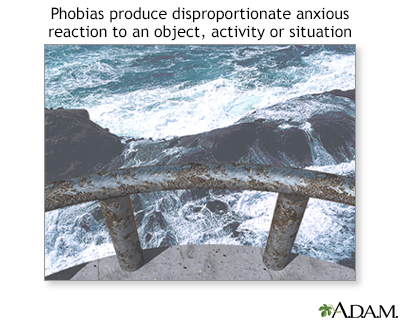Phobias: They aren’t just in your head, including a fear of sharks
More than 8 percent of the U.S. population has been diagnosed with some type of phobia, with the most common being social phobias, according to the National…

Update your location to show providers, locations, and services closest to you.
A phobia is an ongoing intense fear or anxiety of a certain object, animal, activity, or setting that poses little to no actual danger.
Anxiety disorder - phobia
Specific phobias are a type of anxiety disorder in which a person may feel extremely anxious or has a panic attack when exposed to the object of fear. Specific phobias are a common mental disorder.
Common phobias include the fear of:
Being exposed to the feared object or even thinking about being exposed to it causes an anxiety reaction.
You avoid settings in which you may come into contact with the feared object or animal. For example, you may avoid driving through tunnels, if tunnels are your phobia. This type of avoidance can interfere with your job and social life.
The health care provider will ask about your history of phobia, and will get a description of the behavior from you, your family, or friends.
The goal of treatment is to help you live your daily life without being impaired by your fears. The success of the treatment usually depends on how severe your phobia is.
Talk therapy is often tried first. This may involve any of the following:
Certain medicines, often also used to treat depression, may be very helpful for this disorder. They work by preventing your symptoms or making them less severe. You must take these medicines every day. DO NOT stop taking them without talking with your provider.
Medicines called sedatives (or hypnotics) may also be prescribed.
If you are prescribed a sedative, do not drink alcohol while on this medicine. Other measures that can reduce the number of attacks include:
Phobias tend to be ongoing, but they can respond to treatment.
Some phobias may affect job performance or social functioning. Some anti-anxiety medicines used to treat phobias may cause physical dependence.
Contact your provider for an appointment if a phobia is interfering with life activities.

American Psychiatric Association website. Anxiety disorders. In: American Psychiatric Association, ed. Diagnostic and Statistical Manual of Mental Disorders. 5th ed. Arlington, VA: American Psychiatric Publishing; 2013:189-234.
Calkins AW, Bui E, Taylor CT, Pollack MH, LeBeau RT, Simon NM. Anxiety disorders. In: Stern TA, Fava M, Wilens TE, Rosenbaum JF, eds. Massachusetts General Hospital Comprehensive Clinical Psychiatry. 2nd ed. Philadelphia, PA: Elsevier; 2016:chap 32.
Lyness JM. Psychiatric disorders in medical practice. In: Goldman L, Schafer AI, eds. Goldman-Cecil Medicine. 26th ed. Philadelphia, PA: Elsevier; 2020:chap 369.
National Institute of Mental Health website. Anxiety disorders. www.nimh.nih.gov/health/topics/anxiety-disorders. Last Reviewed April 2022. Accessed August 12, 2022.




More than 8 percent of the U.S. population has been diagnosed with some type of phobia, with the most common being social phobias, according to the National…
